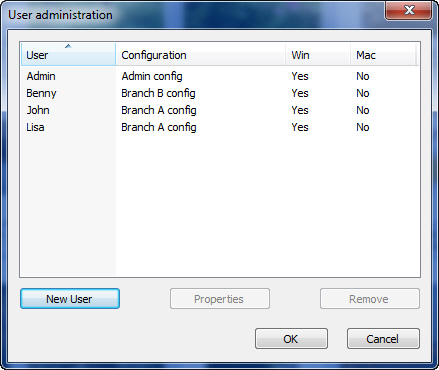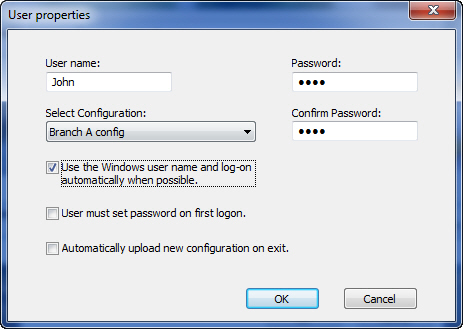
When used in a network environment, FotoStation can be configured to load a centrally located configuration from a server. A server administrator can use FotoStation to manage users and assign different configurations to different users so that the correct configuration is downloaded when the user supplies a user name and password.
Initial Tip:
If you want to start from absolute scratch with a completely blank configuration so that you can set it up as you please, open the File menu (FotoStation Pro menu on the Mac), select Manage configurations, then New configuration. FotoStation will then restart and load a blank configuration that you can configure as you see fit before proceeding.
To make a configuration and upload it to a network access, start by configuring FotoStation as you would like it to appear to network users. Then, when you have made all necessary adjustments, open the File menu (FotoStation Pro menu on the Mac), select Manage Configurations and then choose Upload configuration to server…
Next, choose a publicly accessible network drive and create a folder named FotoStation Logon on it. You may of course create the folder inside another folder if you like, but the folder to which the containing is uploaded MUST be named FotoStation Logon.
Now you have two main options to choose between:
Create a new configuration: Choosing this option will make FotoStation save the configuration in the FotoStation Logon folder. Simply choose a name for the configuration. You should choose this option if you intend to create more than one centrally located configuration and associate different users with different configurations.
You may also choose whether text editor files (i.e. text editor layouts, quicklists and thesauruses) and data files (i.e. prefix lists, print templates and web templates) should be shared between all configurations, if they should be kept separate for each configuration or if they should not be saved at all. When choosing the latter, only the local versions of these files will be available in FotoStation.
Create a default configuration: If you intend to let all FotoStation clients on the network access a single configuration, choose this option. This eliminates the need to specify users and associating configurations with them.
If you have more than one configuration stored on the network server, you will need to create user accounts that can be associated with the different configurations. Do so by opening the File menu (FotoStation Pro menu on the Mac) and selecting Manage configurations and then User administration. Locate the FotoStation Logon folder and click OK to proceed to the user administration window.

Creating a user and associating a configuration
To create a user, click on the New User button. Then specify a user name and password. If you do not specify a password, any user can log on and download the user’s associated configuration. Using the Select Configuration dropdown list, choose the configuration you want to associate with the user.

Use the Windows user name and log-on automatically when possible: If you choose this option FotoStation will automatically try to determine if the user’s Windows / Mac OS logon account has a matching account in the FotoStation user base, and if it does, that user’s configuration will be loaded automatically. However, if no matching account exists, the user must manually select a user name and enter a password when starting FotoStation.
User must set password on first logon: Forces the user to choose a password when logging on for the first time. The user logs on by entering her username and choosing a password. She will then be required to verify the password before FotoStation loads the configuration.
Automatically upload new configuration on exit: By selecting this option, the user in question can make changes to the configuration which will be automatically uploaded to the server when he / she exits FotoStation. Under normal circumstances, any changes made to the configuration on the server will disappear when the program is restarted, since the original configuration on the server will be downloaded again and any changes abandoned. In other words, this option should typically only be enabled for system administrators.
Changing user properties
To change any of the user properties described above, you can click on a user in the user list and click on the Properties button.
Removing a user
To remove a user, click on the user name in the list of users and click on the Remove button
To configure a FotoStation client to download a configuration from the network when it is started, open the File menu (FotoStation Pro menu on the Mac), choose Configuration, then click on the FotoStation Configuration node in the tree. Now select Log on and load configuration from a server and specify the path to the FotoStation Logon folder on the server. If FotoStation is running on a laptop that may sometimes be disconnected from the network, select the Enable Work offline option checkbox. Finally, click on the OK button to close the configuration window. Now you can quit and then restart FotoStation to use the central configuration.
Updating a configuration
To update a configuration after you have made changes to it, open the File menu (FotoStation Pro menu on the Mac), choose Manage configurations, then Upload configuration to server. Locate the FotoStation Logon folder and click OK, then select Update an existing configuration and choose the configuration to update in the dropdown list.
A note about updating configurations: When FotoStation is configured to use a centrally stored configuration, any changes that the user makes to the configuration, such as creating new archives and actions, will not be saved when the user quits the program. Upon a program restart, FotoStation will load the configuration from the server again and any changes the user made during the last session will be gone. This behavior is intended, since it makes it impossible for users to make permanent changes to the centrally stored configuration. A system administrator can restore the original configuration simply by restarting the program.
To update the configuration, either a FotoStation user account has to have “upload configuration on exit” privileges set in the user administration (as described above), or the configuration has to be updated manually, as described in the above paragraph.
If the network is down, a message will inform the user that the network folder is unavailable FotoStation will use the last good configuration, which has been cached to the local disk.
When FotoStation is configured to load a configuration file from a server, you can enable an offline working mode. (This is done in the FotoStation Configuration node in the program configuration window.) This way, FotoStation can operate with two different configurations depending on whether the computer is connected to the office network or working independently.
Saving and using an offline configuration
To create a configuration to use offline, start by setting up FotoStation with access to the local folders and actions that you need. Then, simply open the File menu (FotoStation Pro menu on the Mac), choose Manage configurations, then Save offline configuration. This will save the active configuration locally for offline use so that it can be accessed when you start FotoStation and choose Work offline on the splash screen. When the computer is connected to the office network, simply log in with your user name and password as usual.
FotoStation lets you make a backup copy of the active configuration for safekeeping, for example on a backup disk or a memory stick. By default, it will suggest storing the backup configuration on the local disk, but you can choose any location you want. The backup contains your entire configuration (archives and actions, text templates and macros, image markers, archive/action icons - the lot).
To back up the active FotoStation configuration, open the File menu (FotoStation Pro menu on the Mac) and choose Manage configurations. Next, choose Backup configuration. A Save file dialog box lets you choose a location for storing the backup configuration. In the folder you choose, FotoStation will create a subfolder named after the current date and time where the configuration will be stored. Click OK to create the backup configuration.
To restore a previously backed-up configuration, open the File menu (FotoStation Pro menu on the Mac) and choose Manage configurations. Next, choose Restore configuration. Locate the folder containing the backup files and open the folder named after the date when the configuration was backed up. (Typically something like 07.09.2007 08_58_35). Then click OK. FotoStation will display a message saying that it needs to restart to load the chosen configuration. Simply click OK to proceed.
Important: Restoring a configuration will overwrite the currently active configuration.